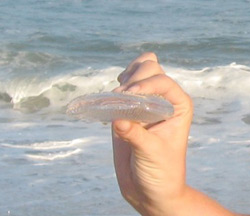
Aurelia aurita
This is one of the most common jellyfishes found on the beach in New Jersey. When washed up on shore they look like a round disk-shaped pad of hardened jelly. Most of the moon jellyfish you find are about 4 or 5 inches in diameter. The disk that washes up on shore is the most durable remnant of this creature.
This video below shows a different species than the one the lives of the coast of New Jersey but its behavior and appearance is very similar to our local moon jellyfish. One of the moon jellyfish's defining features is the interesting pattern in the center of the disk. In some individuals it resembles a loosely arranged four leaf clover pattern. What is to us an interesting design is actually the reproductive organs.
This jellyfish is a carnivore. It eats plankton that it catches while floating in the water column. Their prey includes a wide variety of small organisms like juvenile mollusks and crustaceans, rotifers, young polychaetes, protozoans, diatoms, tunicate larvae and fish eggs. Tentacles that hang down from the underside of the animal sweep the water, entangling whatever it encounters. Stinging nematocysts are effective at killing their prey and secreted mucus helps hold onto ensnared plankton. Captured food is moved via flagellar movement towards canals along the underside of the disk, then moved by other smaller flagella into the stomach.
Moon jellyfish's stinging cells are relatively benign to us. In some cases a person may experience some mild stinging sensation if stung. The discomfort is fairly localized and does not persist for a long period of time. The disks you see on the beach usually have few if any tentacles remaining attached hence there are no stinging nematocysts present.
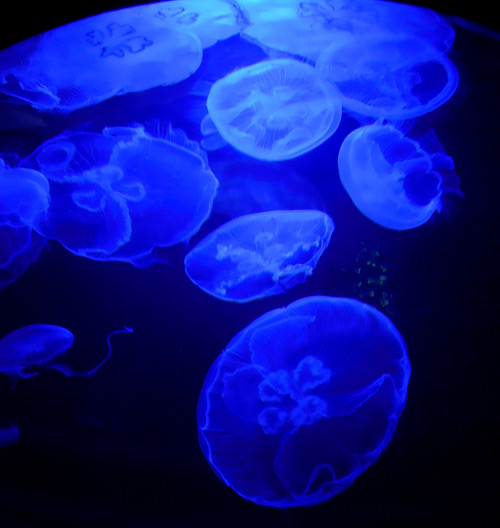
Having no lungs or other dedicated respiratory organs, jellyfish breathe by diffusion. Oxygen is obtained from water that is pulled into the gastrovascular cavity (i.e., their stomach).
Moon jellyfish tend to stay close to the water surface, in large part because this is where there is the highest concentration of plankton. This behavior makes the jellyfish themselves susceptible to being eaten. Moon jellyfish are preyed upon by various large fish, turtles and even some birds. Another consequence of living close to the water surface is that the jellyfish are moved around by water currents. Moon Jellyfish can manipulate their bell shaped body to thrust water away from them and propel themselves forward. Their rhythmic propulsion is largely a means to move up or down in the water column. They can only move in one direction though and they are not powerful enough to outpace even a moderate water current. Since plankton are also moved by these same currents, and also tend to be position themselves at different depths by their own movements, the combination of up-and-down movement and drifting does work well for keeping the jellyfish in places that are rich in food. Their limited ability to control their movements does mean they are susceptible to being washed ashore by currents and tidal action.
Fortunately the stingers of this species are relatively mild. Most people that come into contact with moon jellyfish have little reaction. Some may feel a bit of a stinging sensation but even this can be relatively mild compared to what can occur with more troublesome jellyfish species. Many moon jellies you find no longer have any stingers attached to them.
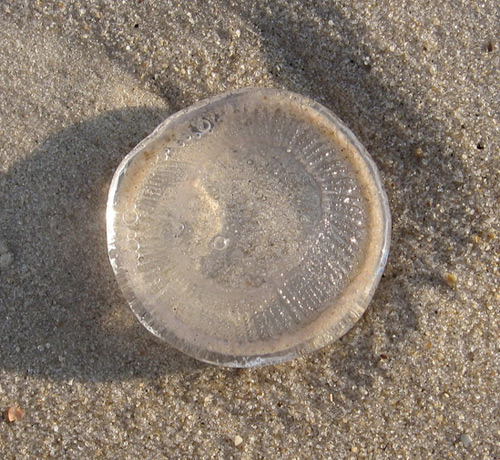
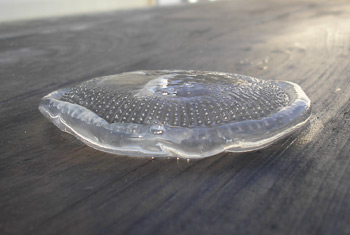
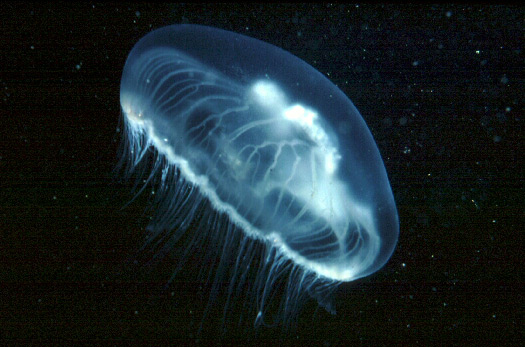
The first and third picture on this page are presented here under a creative commons license and were graciously provided by ethorson
Return to the Beachcombing page
Return to the top of the page
